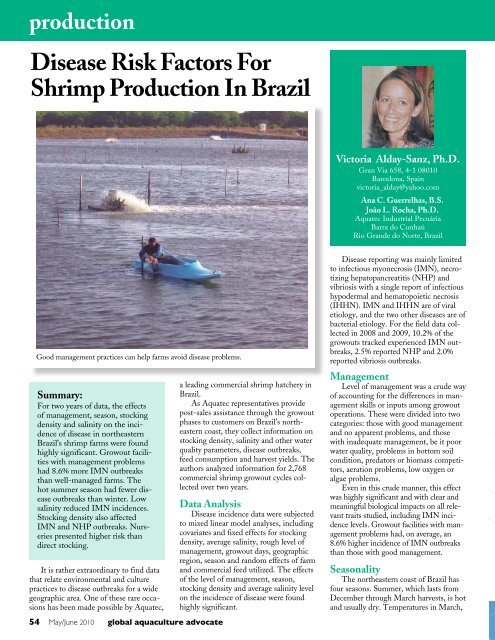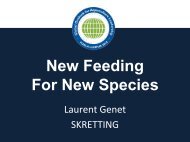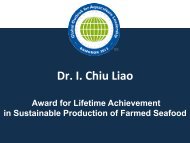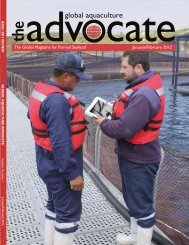May/June 2010 - Global Aquaculture Alliance
May/June 2010 - Global Aquaculture Alliance
May/June 2010 - Global Aquaculture Alliance
Create successful ePaper yourself
Turn your PDF publications into a flip-book with our unique Google optimized e-Paper software.
production<br />
Disease Risk Factors For<br />
Shrimp Production In Brazil<br />
Good management practices can help farms avoid disease problems.<br />
Summary:<br />
For two years of data, the effects<br />
of management, season, stocking<br />
density and salinity on the incidence<br />
of disease in northeastern<br />
Brazil’s shrimp farms were found<br />
highly significant. Growout facilities<br />
with management problems<br />
had 8.6% more IMN outbreaks<br />
than well-managed farms. The<br />
hot summer season had fewer disease<br />
outbreaks than winter. Low<br />
salinity reduced IMN incidences.<br />
Stocking density also affected<br />
IMN and NHP outbreaks. Nurseries<br />
presented higher risk than<br />
direct stocking.<br />
It is rather extraordinary to find data<br />
that relate environmental and culture<br />
practices to disease outbreaks for a wide<br />
geographic area. One of these rare occasions<br />
has been made possible by Aquatec,<br />
a leading commercial shrimp hatchery in<br />
Brazil.<br />
As Aquatec representatives provide<br />
post-sales assistance through the growout<br />
phases to customers on Brazil’s northeastern<br />
coast, they collect information on<br />
stocking density, salinity and other water<br />
quality parameters, disease outbreaks,<br />
feed consumption and harvest yields. The<br />
authors analyzed information for 2,768<br />
commercial shrimp growout cycles collected<br />
over two years.<br />
Data Analysis<br />
Disease incidence data were subjected<br />
to mixed linear model analyses, including<br />
covariates and fixed effects for stocking<br />
density, average salinity, rough level of<br />
management, growout days, geographic<br />
region, season and random effects of farm<br />
and commercial feed utilized. The effects<br />
of the level of management, season,<br />
stocking density and average salinity level<br />
on the incidence of disease were found<br />
highly significant.<br />
Victoria Alday-Sanz, Ph.D.<br />
Gran Via 658, 4-1 08010<br />
Barcelona, Spain<br />
victoria_alday@yahoo.com<br />
Ana C. Guerrelhas, B.S.<br />
João L. Rocha, Ph.D.<br />
Aquatec Industrial Pecuária<br />
Barra do Cunhaú<br />
Rio Grande do Norte, Brazil<br />
Disease reporting was mainly limited<br />
to infectious myonecrosis (IMN), necrotizing<br />
hepatopancreatitis (NHP) and<br />
vibriosis with a single report of infectious<br />
hypodermal and hematopoietic necrosis<br />
(IHHN). IMN and IHHN are of viral<br />
etiology, and the two other diseases are of<br />
bacterial etiology. For the field data collected<br />
in 2008 and 2009, 10.2% of the<br />
growouts tracked experienced IMN outbreaks,<br />
2.5% reported NHP and 2.0%<br />
reported vibriosis outbreaks.<br />
Management<br />
Level of management was a crude way<br />
of accounting for the differences in management<br />
skills or inputs among growout<br />
operations. These were divided into two<br />
categories: those with good management<br />
and no apparent problems, and those<br />
with inadequate management, be it poor<br />
water quality, problems in bottom soil<br />
condition, predators or biomass competitors,<br />
aeration problems, low oxygen or<br />
algae problems.<br />
Even in this crude manner, this effect<br />
was highly significant and with clear and<br />
meaningful biological impacts on all relevant<br />
traits studied, including IMN incidence<br />
levels. Growout facilities with management<br />
problems had, on average, an<br />
8.6% higher incidence of IMN outbreaks<br />
than those with good management.<br />
Seasonality<br />
The northeastern coast of Brazil has<br />
four seasons. Summer, which lasts from<br />
December through March harvests, is hot<br />
and usually dry. Temperatures in March,<br />
in the Family<br />
Alltech ® has developed a range of products to address dietary requirements at different<br />
stages of life in aquaculture species. These sustainable product solutions are proven to<br />
support profitability in aquaculture operations as well as performance in fish and shrimp.<br />
Ideally suited for fish and shrimp in any stage of life to maintain performance and to<br />
support independence from traditional aquaculture diet ingredients.<br />
Specifically designed for the juvenile stages of life in fish and shrimp to support good<br />
health, uniform growth and survival.<br />
A natural, affordable product created for salmon in all life stages to maintain good<br />
health and defense mechanisms against adverse aquatic elements present in the<br />
surrounding environment.<br />
Give your fish and shrimp the Alltech Aqua Advantage.<br />
Contact your Alltech representative today<br />
for more information.<br />
aquasolutions@alltech.com<br />
www.alltech.com<br />
54 <strong>May</strong>/<strong>June</strong> <strong>2010</strong> global aquaculture advocate global aquaculture advocate <strong>May</strong>/<strong>June</strong> <strong>2010</strong> 55





